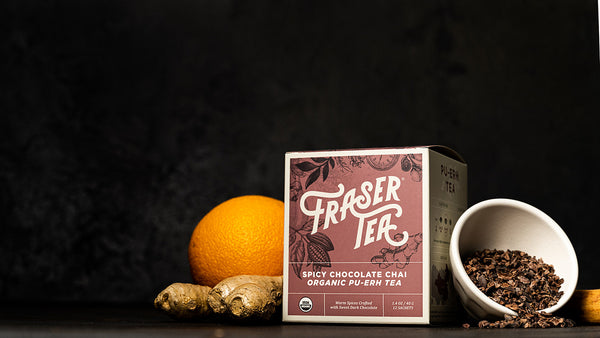The Rich History Behind Every Cup of Chai

Few drinks in the world carry as much tradition, warmth, and cultural richness as a cup of chai. A story that spans thousands of years, rooted in ancient Ayurvedic practices and shaped by colonialism, chai remains one of the most popular forms of tea today. The word its beginnings as a medicinal blend of herbs and spices in India, to its evolution into the sweet, milky comfort so many know today, chai’s history is as layered and aromatic as the drink itself.
What is Chai?
The word “chai” used differently today than it was traditionally. In Hindi, meaning “tea”, chai was used to describe a healing concoction of herbs and spices. It did not contain any tea leaves until much later in history. Today, there are many different types of chai:

- Kadak Chai: The most traditional use of the word, describing the herbs, spices, leaves and flowers for medical purposes.
- Masala Chai: Commonly just “chai”, this is what most people think of when they picture chai. It is a combination of black tea, spices, and milk.
- Adrak Chai: A ginger chai popular in Northern India.
- Sulaiani Chai: A beautiful golden color, this minty chai has no milk.
- Elaichi Chai: A fragrant chai highlighting cardamom.
- Kashmiri Chai: A pink-hued tea often prepared with green tea, milk, and pistachios.
- Cutting Chai: Famous in Mumbai, this is chai served in small glasses, perfect for a quick sip.
Chai’s Origins and Evolution
Now, the origin of chai tea is truly folklore, but it is long traced back to India. There is a traditional form of Hindi medicine known as Ayurvedic. Still practiced today, Ayurvedic is one of the oldest and most complete natural medicines. More holistic than traditional western medicine, Ayurvedic aims to treat diseases at the source rather than treating symptoms. Things like diet, biological rhythms, medication, and eliminating toxins in the body are the central focus of Ayurvedic. According to Indian folklore, a king in the royal court of India wanted to create a drink with Ayurvedic properties. He gathered ingredients based on their known benefits, creating a concoction of cardamom, cinnamon, black pepper, ginger and cloves - thus creating Karak chai. As stated above, traditional chai did not contain tea leaves.
Decades later, British colonization entered the Indian subcontinent. Wanting to cut the Chinese monopoly on tea, British botanists from the British East India Company smuggled tea leaves from China into India. Tea requires very specific growing conditions, and the smuggled tea plants first took hold in the Darjeeling region of India. In the 1830s, commercial tea plantations began to grow, despite Indian resistance. During British colonialism in India, the average Indian could not afford the luxury tea leaves. The majority of product was sent abroad, and the remaining was sold to upper-class Europeans. In the early 1900s, economic depression hit Britain. Unable to export tea abroad, marketing campaigns targeted upper-class Indians. Early advertisements illustrated how to prepare tea the British way, adding milk, but Indians naturally developed their own methods. They began steeping tea directly in milk, and adding things like ginger, cardamom, and cinnamon. It is through these practices that we suspect traditional Masala chai originated.
Chai Today
The 1920s-30s was a time of economic depression in India. Instead of being pushed to just the upper-class, tea become a drink for all people. Then between 1930 and 1950, tea became associated with the nationalist push for Indian independence from Britian. In 1947, Indian declared independence and tea became a Indian drink. Exports decreased, and most production was being sold domestically. The “crush-tear-curl” (CTC) process for shredding tea leaves allowed for more tea to be made from the same number of leaves. A Bengali engineer redesigned the CTC machinery, leading to CTC tea becoming commonplace.
In the years that followed, tourists and emigrants were exposed to the Indian traditions of brewing chai. Companies like Starbucks and other caffes spread the word “chai”, selling their own variations of the tea. However, to this day in India, Masala chai remains a traditional, affordable drink for all.

At Fraser Tea, we offer a collection of many differently spiced chai. If you are looking for a more traditional chai, try our Masala Chai Organic Black Tea. Or if you want a spicier flavor, try our Poppin Chai Organic Black Tea, or our Spicy Chocolate Chai Organic Pu-erh Tea. While these blends don’t need milk, you could add a splash of your favorite dairy product to get the traditional chai tea experience. No matter how it’s made, every cup carries with it a piece of history: a reminder of ancient traditions, cultural exchange, and the timeless comfort of gathering over something warm and fragrant. Chai’s story is still being written, one cup at a time… and that’s part of what makes it so special.
References:
- Downs, Alex. “All the Tea (Not) in China: The Story of How India Became a Tea-Drinking Nation.” Serious Eats, Serious Eats, 2 Oct. 2023, www.seriouseats.com/indian-tea-history-5221096.
- Erdal, Eylül. “A Short Timeline of India Becoming a Tea-Drinking Nation.” Istanbul Chronicle, Istanbul Chronicle, 19 Aug. 2022, www.theistanbulchronicle.com/post/a-short-timeline-of-india-becoming-a-tea-drinking-nation.
- Pal, Sanchari. “India in a Tea Cup: The Fascinating History of India’s Best Loved Beverage, Chai.” The Better India, 15 Dec. 2016, thebetterindia.com/78265/chai-tea-history-india/.
- Sharma, Hari. Ayurveda (Science of Life), wexnermedical.osu.edu/-/media/files/wexnermedical/patient-care/healthcare-services/integrative-medicine/services/ayurveda/ayurveda-flyer-osu-cih-22024ada.pdf?rev=dbec616d5b5f438bb75f06463684d35f&hash=AD2DDE5669E05C91B07949372B834FBC. Accessed 3 Oct. 2025.
- Sharoff, Andrea. “Chai A-Z: A Full Guide to Each Type of Chai.” Kimbala, Kimbala, 4 July 2021, ikimbala.com/blogs/chai-101/types-of-chai.
- Sharoff, Andrea. “The Origins of Chai.” Kimbala, Kimbala, 5 July 2021, ikimbala.com/blogs/chai-101/the-origins-of-chai.